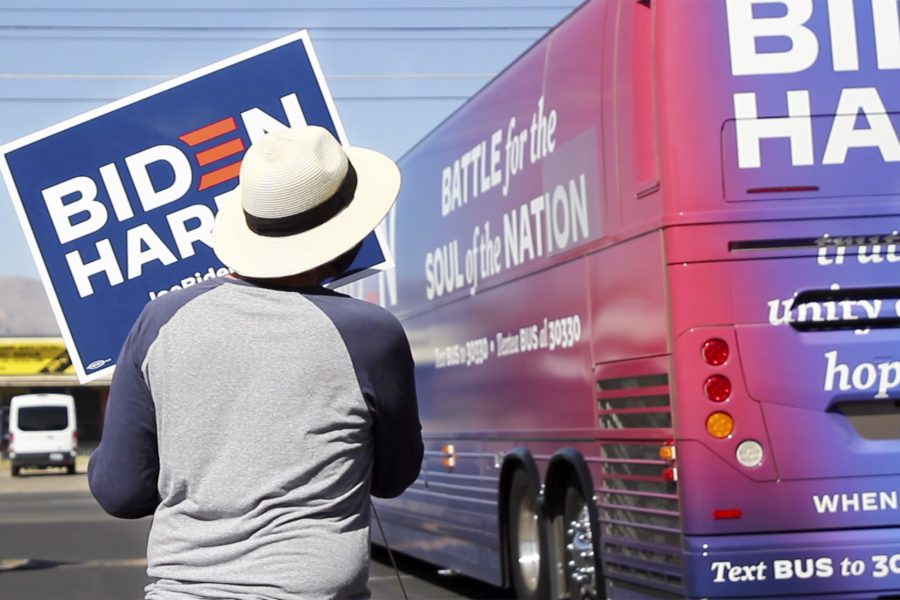Editor’s Note: This story was produced as part of the Daily Wildcat’s “Election Guide” special print edition, published Wednesday, Oct. 21, and available on campus or online.
Traditionally, Arizona has had great consistency in being red: the red rocks, the red sunsets and being a red state. Rooted in its Western heritage, Arizonans tend to consider their individual liberties and ideas of small government to be of great importance to them.
If you’ve lived in Arizona for a long time, you don’t think twice when you see something like supermarket shoppers and movie theater goers wearing firearms. As the 2020 elections draw closer, it is becoming increasingly clear that Arizona’s long-perceived stance as a red, or Republican, state could shift to change the entire election.
With Republican dominance in the state offices, Arizona does tend to lean more right.
RELATED: What the university is doing to protect UA essential workers
“Arizona has stayed Republican for so long and tends to be politically conservative because of the belief that we are a free state, the adoption of Republican principles, keeping the government out of our hair, … a true free Western state,” said Pima County Republicans First Vice Chairman Chris King.
While Arizona has long sported the title of being a red state, it has never truly been as red as people believe in elections. Therefore, the idea of it turning blue is really not shocking to political experts, like University of Arizona public policy professor Thomas Volgy.
“It was considered a ‘pink’ state, capable of turning purple or blue,” Volgy said via email. “However, it wasn’t tested previously because the national democratic party never really put much resources into the state in the past.”
UA professor Barbara Norrander also spoke on Republican prominence in Arizona.
“Republicans have been the dominant party in Arizona for several decades,” Norrander said via email. “The best indicator of this is for lower-level offices where the vote is based more on the party labels. The Republican Party has controlled the state legislature for many decades. Republicans also tend to win the statewide races, such as for governor. Arizona senators also have tended to be Republicans.”
RELATED: UA Webinar examines US-China relations since COVID-19
Reading or listening to the news, Arizona has continued to come up again and again as one of the most important states in the presidential election with it being a “swing state.” According to Norrander, a swing state is a state where either party could win both the presidency and the Senate seat. Arizona being a swing state is not a new concept. With uncertainty on which way Arizona would go in the last election, it going red was surprising to some. How unpredictable is this swing, though?
“It could really go either way. Things can change before election day, we won’t know until it actually happens,” said UA law student and Get Out The Vote member Christina Billhartz.
Political experts believe that the chances of Arizona going blue are much higher than we think, though, according to polling and data.
“All the demographics and polling suggest that the chances of Arizona going blue, depending on turnout in the next couple of weeks, is better than 50-50,” Volgy said via email. “The demographics suggest that if that happens, it is likely to stay that way, with Arizona having two U.S. Senators, and probably a majority of its representatives.”
Norrander said that though presidential candidate Joe Biden and Arizona Senatorial candidate Mark Kelly are ahead in the polls, it’s not a guarantee they’ll respectively win.
“The key to Arizona elections is often in Maricopa county, where 3 out of 5 Arizonans live,” Norrander said via email. “So any changes in Maricopa county could change the outcome statewide. The place to look is at the Phoenix suburbs, with some remaining Republican and some showing signs of becoming more Democratic.”
So what is causing this great shift in Arizona in recent years? The answer can’t be condensed down to one factor, but the biggest reason is political strength in the form of new residents.
“Growth in Latino strength politically (Democratic voters), the loss by Republicans of suburbanites disgusted with the present administration, and an influx of new residents who lean more Democratic,” Volgy said.
Along with this, the general dissatisfaction with the Republican party is stronger than ever as COVID-19 continues to plague the state and nation. Small businesses, which have a strong presence in Arizona, were hit harder than ever, with little help from the government. The discussion of handlings/mishandlings is a key issue for some people as they head to the polls, according to Billhartz.
The breakdown of Arizona voter demographics stays relatively the same, with much of the swing vote riding on the Independent and unaffiliated voters.
“In terms of numbers, rural parts of Arizona are going to stay red, reservations and Pima County are going to stay blue, Maricopa County is probably going to stay pink and maybe go purple … The swing vote is going to go to the independents,” King said.
The idea of independent voters deciding the election is prominent in all swing state discussions but has been especially emphasized recently around Arizona. Arizona is 31.92% unaffiliated, 32.41% Democrat, 34.84% Republican and a whopping .83% Libertarian, with 32,965 Arizonans registered as Independent. This means that the swing will ultimately go to the Independent voters and the unaffiliated that end up voting.
Another big election that will affect Arizona’s ‘swing’ and solidify a purple status, is that of the Senate election. The race between incumbent Senator Martha McSally and Captain Mark Kelly has gained national attention and is one multiple battleground Senate race that will decide the future of the US Senate, along with Georgia, South Carolina and Kentucky. As election day gets closer, Kelly continues to poll significantly higher than McSally, almost guaranteeing a win for him in November.
“Arizona is one of the states that is a battleground state — both parties think they have a chance of winning the presidential election. Also, the Arizona senate seat is a must win for both parties,” Norrander said. “One indicator of the importance of Arizona to both the presidential and senate races is the amount of money that is being spent in the states by all of the candidates.”
While battleground races occur every election, one of the most glaring reasons behind the Republicans hard fight to keep control of the house lies in the confirmation of Amy Coney Barrett. Any new Democratic senators will be one more vote against the confirmation of Amy Coney Barrett, with only four more votes needed.
No one will know for sure which way Arizona will go until results are in, but one thing is for sure: the importance of Arizonans voting is more critical than ever, no matter where you stand.
Follow Maggie Rockwell on Twitter









